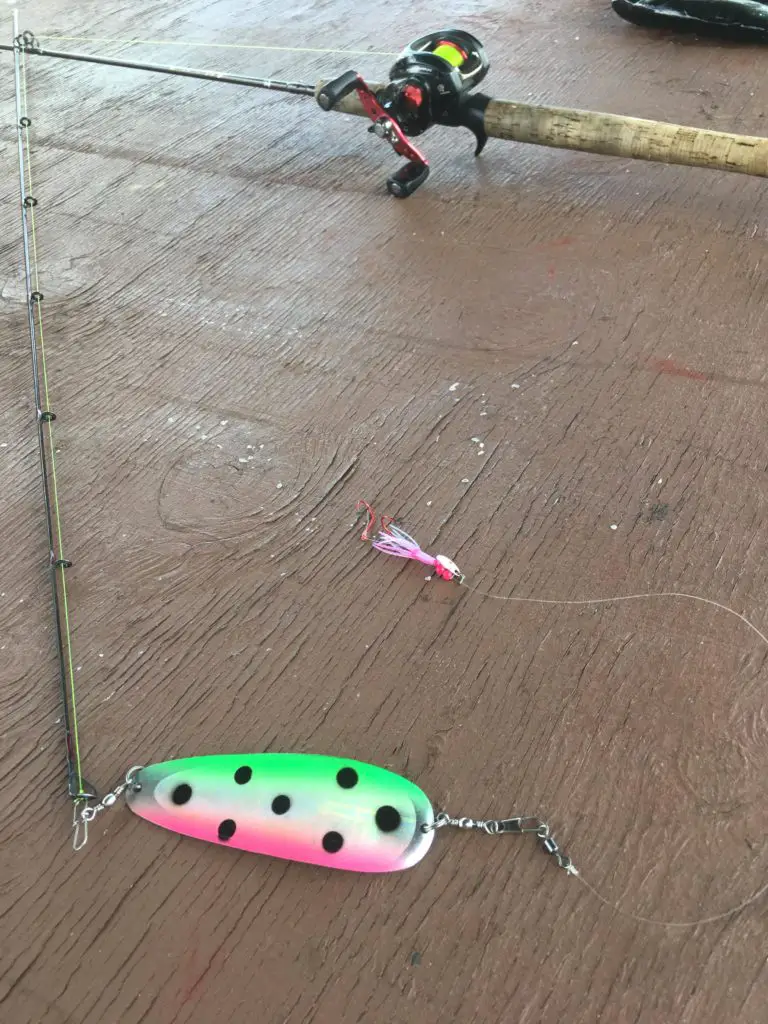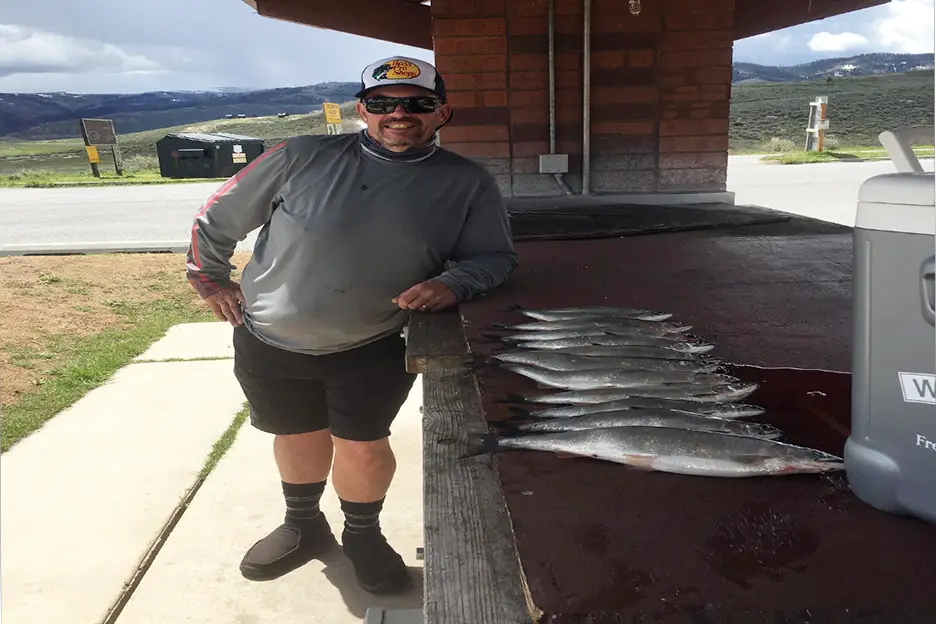I’m a generalist when it comes to fishing, I will fish for and catch whatever species is biting on the body of water I’m on. My style of fishing relies on knowing the current conditions and applying a proven formula to target and catch those fish.
It is summertime in Utah so that means it’s a good time to target Kokanee, we are fortunate to have two world class Kokanee fisheries in Utah, Strawberry and Flaming Gorge. The tactics, tackle and gear discussed in this article are universal and will catch Kokanee and other salmonid species in any lake where they are present.
The three major consideration to consistently catching kokanee are depth, speed and presentation. The goal of this article is to give you the small details that will improve your chances of consistently catching kokanee.
Kokanee Biology
In order to effectively target any species of fish it is helpful to understand their biology in relation to their behavior. Kokanee are land locked Sockeye Salmon that make their living eating zoo plankton, this is important because their food source will determine where you find them. Zoo plankton live at the thermocline, a layer in the water column that maintains a constant temperature of around 54 degrees Fahrenheit.
Early in the spring before the Thermocline sets up the Kokanee are scattered throughout the water column and can be caught from the surface down to 50 feet or more, we are going to talk about the summer pattern in this article. This is where the discussion of depth comes into play.
Depth
How deep should I start fishing and how do I accomplish that? There are several ways to determine the depth to start fishing, the first and most common is to ask or read recent reports, another is to use your electronics to locate the schools of fish and another is to use a temperature probe to find the thermocline. There are several methods to get down to where the fish live, lead core line, divers, snap weights and downriggers. My preferred method is downriggers and that is what I am going to talk about.
Before my last trip in the third week of June at Strawberry Reservoir, I read several recent reports that kokanee where being caught at 30 feet, that gave me a starting point. In my boat, I run two stacked downriggers. Stacking is a technique where you fish two or more lines off of a single down rigger.
When you run multiple lines it is important to stagger your depths and setbacks to prevent tangles when you turn and to stay on the fish when the thermocline moves as the water temperature changes throughout the day. The bottom lines will be setback 10’ longer and 10’ deeper on the downrigger. The length of your setback is determined by the depth you are fishing, the deeper you are fishing the less setback is required.
When the fish are up near the surface they will scatter as your boat passes over them and a longer set back gives them an opportunity to come back into your offerings, but shorter setbacks reduce the likelihood that you will lose these notoriously soft mouthed fish when hooked. I typically use a setback of 70’ in the top 20’ of the water column and reduce it by 10’ for every 7’of the depth after that.
On my last outing I initially had one side of the boat set at 30’ and 20’ deep with the other side set at 35’ and 25’ deep. I caught fish at all of these depths, with the majority of the kokanee at 30’ and mainly cutthroats at the others depths. Later in the day I moved to another location on the Lake to try and get out of the wind and found that I was catching the kokanee at 20’ feet, I left the one side at 20’ and 30’ and set the other to 25’ and 15’.
Speed
Speed and direction is the next factor to consider, a good starting point for speed is 1.5 mph for Kokanee. When trolling it is important to make S turns with your boat, because there is nothing in nature that swims all day long in a straight line at a constant speed. When you turn the boat the setup on the outside of the turn speeds up and the inside slows down. The change of direction and speed often times trigger strikes.
By making note of which side you get bit on, you can tell whether to speed up or slow down. I have caught Kokanee going less than 1 mph up to 2 mph. On my last trip 1.8mph was most productive.
Presentation

The last factor is presentation this includes the tackle, scents and baits. There are two main set ups people run for Kokanee they include pop gear with a wedding ring or my favorite the dodger and squid. By far, pink is the most popular and productive color followed by orange and green. There are many brands and sizes of dodger on the market, my go to is Rocky Mountain Tackle 4.25” and 5.5” Signature Dodgers in pink or orange. Squids come in many different colors, sizes, with various blade and bill options, choosing which to use on any given outing is a matter of finding what the fish want that day. Another consideration is the length of the leader between the dodger and squid, the shorter the leader the more action that is imparted on the squid. In most cases I use a 9” leader, but on my latest outing I read a report that said they were biting better on longer leaders and found that a 16” leader was most productive for me. Another way to impart more action on your presentation is to put a bend in your dodgers the greater the bend the more action that is imparted.
Scent
Scent is a critical factor, salmonid species have very good sense of smell, various scents and baits are added to our setups to achieve two goals attracting fish to our presentation and more importantly masking our human scent. It is important to keep your gear clean and as scent free as possible by washing it with dish soap and water after every outing and applying your scents properly when fishing.
There are many different brands of gels and scents to choose from most include ingredients like anise, garlic, sardine and various fish hormones, choose what smells good to you. It is important not to put gels directly onto your squids, it will make them sticky and interfere with their action, gels should be applied to your dodgers and only a small amount is needed.
Until recently the use of corn as bait was outlawed in Utah so most Kokanee anglers tipped there hooks with Berkley Power Maggots in white or pink, but now that corn is allowed white shoe peg corn is a great option that can be doctored up with your favorite scents like garlic, tuna, anise or many others. I put only one corn kernel or maggot on each hook of the squid, adding more will adversely affect its action.
Rod
Rod selection is important when fishing for kokanee, you want a rod that’s in the 7- to 7 1/2-foot range paired with a level wind reel. It should be rated for 4- to 8-pound test and you will want light or ultralight action.
There are many brands of rods designed for kokanee and trout down rigger fishing. I fish on a budget and have found the Okuma Celilo and SST rods paired with an Abu Garcia Black Max bait casting reel a very good option for the money.
Rods specially designed for Kokanee fishing load up very well in your down rigger and allow you to detect when you have fish on, because in my experience the fish rarely pull your line out of the release and what you are looking for is the bounce in the apex of your rod bend.
The rod also acts as a shock absorber, kokanee have very soft mouths and it can be very frustrating to loose multiple fish at the net to stiff rods. If kokanee rods are not in your budget you can use your light or medium action rods with a rubber snubber in front of your dodger to provide shock absorption.
Final Thoughts
The concepts discussed in this article should provide a solid foundation for kokanee fishing success. Once you can consistently catch and enjoy kokanee smoked, grilled or baked you will understand their popularity with the anglers that pursue them. The best tip I can give on consistently catching Kokanee or any species is to put in the time on the water and strive to be the 10% of that catch 90% of the fish.
About the Author
If you have any specific questions or would like to talk fishing my name is Shawn Lindsey and I go by the handle obifishkenobi on the www.bigfishtackle.com Utah board, you can read my post there or send me a private message. I grew up on the central coast of California bass fishing in reservoirs and salt water fishing off the coast, I then lived and fished in North Idaho for 13 years pursuing ocean run Salmon and Steelhead as well as many warm water species. I have lived in Utah since 2012 where I extensively fish Willard Bay for wipers, walleye and catfish and chase kokanee and trout on the hard and soft water at Strawberry, Flaming Gorge and Porcupine. I also frequently fish Palisades, Ririe, Henrys and Mackay in south east Idaho.

